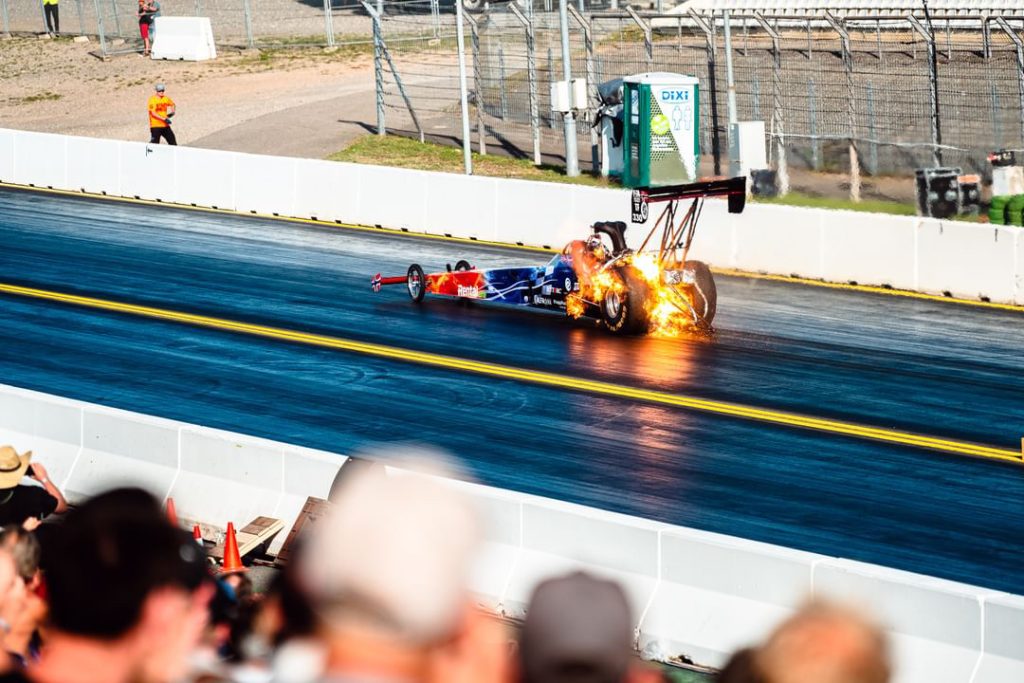What Is TOP FUEL Drag Racing?
The World’s Fastest Motorsport Explained
Drag racing is a high-speed, high-power form of motorsport where two vehicles compete side-by-side in a straight-line sprint. If you’ve ever searched for “what is top fuel drag racing?” or “how fast are Top Fuel cars?” — you’re in the right place.
In this high-octane world, races are won in thousands of a second. Whether you’re new to motorsport or a lifelong fan, drag racing offers raw speed, explosive power, and unbeatable adrenaline.
How Drag Racing Works
The Track: Standard distances are 1,000 feet (used for Top Fuel and Nitro Funny Car) or 1/4 mile (402 meters).
The Start: A countdown light system called the Christmas Tree signals when to go.
The Launch: Reaction time is everything. A perfect start can make or break a run.
The Race: Full throttle from start to finish. Seems easy enough? Trust us, it’s not.




Top Fuel Dragster Facts
Quickest acceleration of any race car
A Top Fuel dragster can hit 100 mph (161 km/h) in just 0.86 seconds — quicker than a fighter jet on takeoff.0–1,000 feet (305 m) in 3.6 seconds
Top speeds reach over 341.58 mph (549.7 km/h) in less than four seconds.Extreme G-forces
Drivers experience an average of 4.0 G and peaks of over 5.6 G — that’s more than astronauts feel during a rocket launch.Burnouts before launch
Burnouts heat the tires and lay fresh rubber, improving grip during the explosive start.Race distance:
Unlike traditional drag races (1/4 mile), Top Fuel runs are now 1,000 feet long, a change made after 2008 to improve safety.Downforce madness
Exhaust gases alone produce up to 1,100 lbs (4.9 kN) of downforce
The rear wing adds 12,000 lbs (53.4 kN) at 330 mph — enough to stick the car to the ceiling if it were upside down
Brutally loud
At full throttle, Top Fuel engines hit 150+ decibels — loud enough to cause permanent hearing damage. Spectators are strongly advised to wear ear protection.Wheelbase limit: 300 inches (7.6 meters)
Source: Wikipedia
Nitromethane: The Fuel That Powers Monsters
Nitromethane is the explosive fuel that powers Top Fuel dragsters — and it’s nothing like regular gasoline. It’s what allows these cars to blast down the drag strip in under 4 seconds. Here’s why it’s so special:
Up to 2.4 x more power than gasoline for the same engine size
➤ Nitromethane contains oxygen in its molecular structure, allowing more fuel to be burned per intake cycle.Air-fuel ratio:
Gasoline: 14.7:1
Nitromethane: 1.7:1
➤ This means you can burn 7.6 times more nitromethane than gasoline in the same amount of air!
Combustion temperature: Around 2,400 °C (4,350 °F)
Laminar flame speed: 0.5 m/s — higher than gasoline
Latent heat of vaporization: Cools the engine as it vaporizes, acting as a built-in heat shield
FIA/NHRA fuel rules: Since 2015, nitromethane fuel mix is limited to 90% nitromethane and 10% methanol max — but teams can run less if needed.
Fuel consumption: A Top Fuel dragster can burn 12–23 US gallons (45–87 liters) of nitro in one run including warm-up and burnout.
Flames from the exhaust:
Yellow flames: leftover nitro igniting in open air
Bright white flames: hydrogen burning without atmospheric oxygen after the oxygen has been fully consumed
Source: Wikipedia



Inside a Top Fuel Engine: The Power Behind 11,000 Horsepower
Ever wondered what powers the world’s fastest accelerating race cars? The Top Fuel dragster engine is a purpose-built masterpiece of engineering, designed to deliver over 11,000 horsepower in just seconds. Here’s what makes it so extreme:
Massive Displacement: Limited by NHRA rules to 500 cubic inches (8.19L), these engines are built for one purpose—maximum power over 1,000 feet.
Billet Aluminum Construction: Unlike typical car engines, everything is custom-machined from solid aluminum blocks for strength, not weight savings.
No Radiator, No Coolant: There’s no water-cooling system. Heat is managed with airflow, fuel, and specially engineered engine oil.
Reinforced Cylinder Block: Uses ductile iron liners and copper head gaskets with stainless o-rings to handle extreme combustion pressure.
Extreme Cylinder Heads: Made from billet aluminum, with titanium intake valves and high-temperature Nimonic alloy exhaust valves.
Advanced Valvetrain: A billet camshaft drives roller lifters, hardened pushrods, steel rocker arms, and dual titanium valve springs—no electronics, just raw mechanical precision.
Forged Pistons and Rods: Aluminum pistons are anodized and Teflon-coated, paired with forged aluminum connecting rods and steel wrist pins for durability under explosive force.
Steel Crankshaft: Custom billet steel crankshafts are designed to endure over 11,000 hp and the violent torsional loads of a Top Fuel run.
Massive Supercharger: A 14-71 Roots-type blower (originally based on GM’s 2-stroke diesel design) crams air into the engine at up to 74 psi boost—consuming nearly 1,000 horsepower on its own.
Built to Withstand the Impossible: Every component—from the titanium fasteners to the proprietary coatings—is selected to survive the most extreme conditions in motorsport.
Source: Wikipedia


